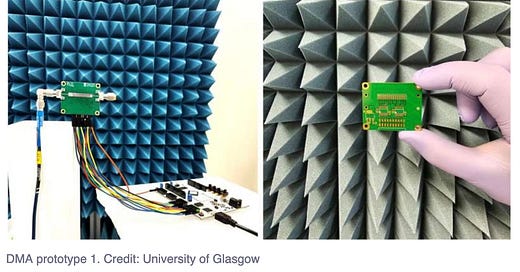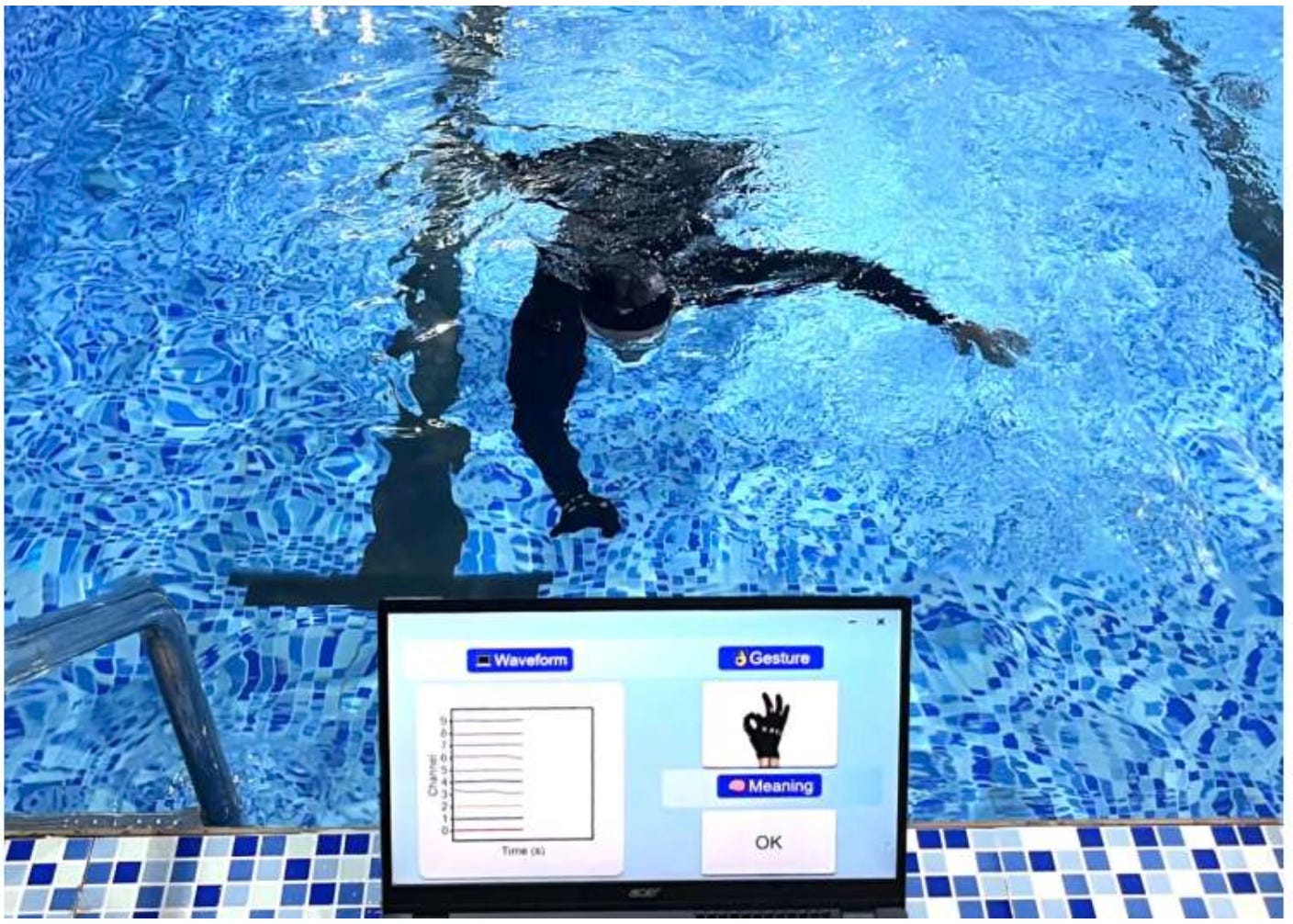This week we examine some new breakthroughs that will help us move to 6G, the next generation of wireless communication protocols. We investigate a new electronic glove that allows divers to communicate with each other and their safety boats. Finally we look at a potential discovery of Alien Life forms and the mysterious Planet 9.
6G Developments
We are not expecting to be able to use the 6th Generation of wireless phone communication until about 2030. A lot needs to be invented between now and then. 6G will use spectrum upwards of 300Ghz and possibly the terahertz range. This will allow speeds of up to 1 gigabyte per second of data transmission. Here are a couple of developments that might be important to future 6G networks.
Metasurface Antenna
A team at Glasgow University has developed an innovative wireless communication antenna that combines the properties of metamaterials and signal processing to create a higher performing dynamic meta surface antenna (DMA). The current prototype works in the 60Ghz range and is a stepping stone to the antennas that will serve 6G data speeds.
The antennas high frequency operation is made possible through the use of specially designed metamaterials that have been engineered to maximize their ability to interact with electromagnetic waves in ways that are impossible with naturally occurring materials. The metamaterials are able to manipulate electromagnetic waves through software control.
The prototype uses high speed interconnects with simultaneous parallel control of individual elements allowing the DMA to shape communications beams and create multiple beams, switching in nanoseconds ensuring stable network coverage.
The improved speed of data transfer may help create holographic imaging of people and objects to be projected anywhere in the world in real time. This may allow improved patient care and monitoring, self driving cars and drones to safely find their way around obstacles on the roads and in the air. It should also allow us to download entire movies in 15 to 20 seconds.
Curving Light
Our current cellular networks and WIFI systems are reaching their bandwidth limits. With 6G we will move to higher frequency transmissions. Unfortunately these transmissions are blocked by solid objects (current systems bounce signals off objects and walls until they find your receiver). Terahertz signals need to be in direct line of sight between transmitter and receiver. To overcome this issue teams at Brown University (Rhode Island) and Rice University (Texas) have developed a way to curve light. This may be the way we overcome the line of sight issue for 6G.
The teams did this by developing self accelerating beams. These are configurations of beams of light (or other wavelengths) that naturally bend or curve to one side as they move through space. The team built transmitters with designed patterns so that the systems could manipulate the strength, intensity and timing of the electromagnetic waves that were produced in each pattern. This allows the light waves to work together to maintain a signal when a solid object blocks a portion of the beam.
The was achieved by adjusting the transmission patterns dynamically. When one pattern is blocked the data transfers to the next pattern. This keeps the signal fully intact. If the signal is fully blocked another way of sending the data will be needed. The team does not yet know how far they can curve the signals.
Waterproof Electronic Glove
Scuba divers use a range of hand signals to communicate when underwater. These signals can sometimes be difficult to see, thus making communication difficult. A team has tried to solve this problem by developing a waterproof “e-glove” that wirelessly transmits hand gestures made underwater.
The gloves are fitted with electronic sensors that can translate hand motions into information. The waterproof sensors rely on flexible microscopic pillars that were inspired by the tube like feet of a starfish. A thin film of polydimethylsiloxane (PDMS), a waterproof plastic used in contact lenses was used to create the pillars. A coating of conductive silver is then applied before two of the films were sandwiched together with the pillars facing inward. This gives a waterproof sensor.
The sensor is responsive when flexed and can detect a range of pressures comparable to the light touch of a dollar bill up to the impact of water streaming from a garden hose. 10 of these sensors were attached to the knuckles and first finger joint of the e-glove.
A vocabulary of 16 hand gestures was created ranging from Ok to Exit. The electronic signals generated by each gesture was recorded. A machine learning technique was then used to translate the gestures into messages. This was then transmitted wirelessly to a safety boat and then forwarded to other divers underwater. The tests showed a 99.8% accuracy in the messages being created, transmitted and received.
Planet 9
Since Pluto was demoted in 2006 to dwarf planet status there has officially been only 8 planets in the Solar System. Pluto had been known as the 9th planet. In 2015 a pair of astronomers at Caltech found several objects at the far edge of the solar system bunched together. That bunching was very unusual unless there was a 9th as yet undiscovered planet whose gravity was causing the phenomenon. This mythical planet soon became known as Planet 9.
Since 2015, researchers have found more evidence of Planet 9 without actually finding the planet itself (space is really big so not everything is easy to find). The movement of many long period objects that cross Neptune’s orbit was tracked and irregular movements were discovered. The teams took into account Neptune’s gravity as well as a force known as the Galactic Tide. This tidal force is a combination of gravitational forces from objects outside the solar system in the Milky Way that still exert some impact on objects distant from the sun.

The conclusion from this work was that the behavior of the objects was best explained by an unidentified planet in the outer reaches of the Solar System. Unfortunately the work did not allow us to locate this mysterious Planet 9. Despite the best efforts of many astronomers we still have not spotted what is expected to be a gas giant planet similar to Neptune.
The work is continuing and as more clues are being found. Astronomers expect we are getting closer and closer to finally finding Planet 9. A new observatory in Chile will open early in 2025 that is better equipped for this type of observation. I expect that there will be an announcement sometime next year that we have finally discovered Planet 9. All that will be left to do, is to name the Planet. Start thinking up names now. There is sure to be some sort of global naming contest.
Alien Life
In September 2023, NASA announced that the James Webb Space Telescope had found a potential sign of life on an exoplanet named K2-18b. The sign of life was the potential presence of dimethyl sulfide (DMS) in the planet’s atmosphere. On earth, DMS is exclusively produced by lifeforms.
On 27 April this year JWST spent 8 hours monitoring this ocean covered distant world a mere 124 light years away (we are not visiting any time soon). JWST found abundant methane and carbon dioxide which has led to speculation that the planet is covered in oceans hundreds of miles deep with a hydrogen rich atmosphere.
This was the first time that we have detected methane on a small planet. The next step is to confirm the presence of DMS. The team examining the observations expect to spend the next 10 months analyzing data with the early results likely to be released late this year. Get ready for a deluge of “Alien Life has been found” headlines and wild conspiracy theories about how and when they first visited earth. The US election will be out of the way by then so we will need something to fill the news void.
Paying it Forward
If you have a start-up or know of a start-up that has a product ready for market please let me know. I would be happy to have a look and feature the startup in this newsletter. Also if any startups need introductions please get in touch and I will help where I can.
If you have any questions or comments please comment below.
I would also appreciate it if you could forward this newsletter to anyone that you think might be interested.
Till next week.





